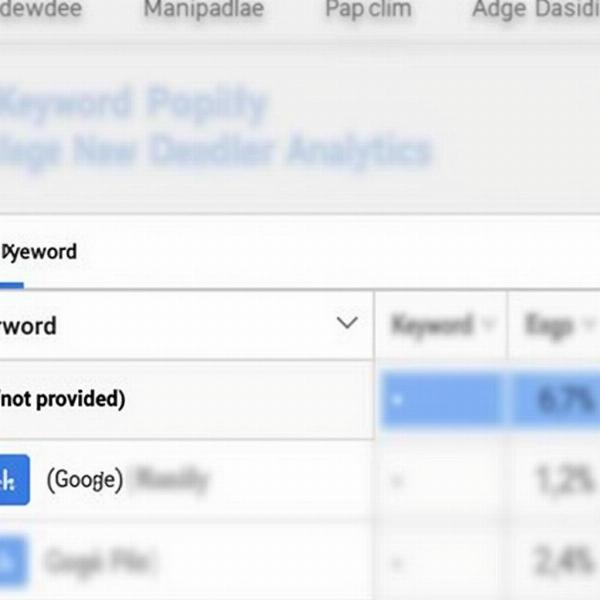“Not provided” in website analytics can be frustrating, especially when trying to understand which keywords are driving traffic to your Hindi website. This article explores the meaning of “not provided” in Hindi, its implications for your SEO strategy, and how you can gain valuable insights despite this limitation. Let’s delve into the world of website analytics and discover how to navigate the “not provided” challenge.
Decoding “Not Provided” in Website Analytics
“Not provided” appears in your website analytics reports when users arrive at your site from a Google search after logging into their Google account. This occurs because Google encrypts search queries made by logged-in users to protect their privacy. While this benefits user privacy, it makes it difficult for website owners to see the specific keywords that led visitors to their site. Imagine someone searching for “best Hindi translation services” and landing on your page, but you only see “not provided” instead of the actual search term. This makes it challenging to optimize your content for specific keywords and understand user search intent.
 Not Provided in Analytics Report
Not Provided in Analytics Report
Impact of “Not Provided” on SEO Strategy
The presence of “not provided” significantly impacts your ability to refine your SEO strategy. Without knowing the exact keywords, you’re left guessing which terms are driving traffic. This can hinder your efforts to optimize content for relevant keywords, potentially leading to missed opportunities. For instance, if you offer specialized legal translation services, knowing whether users are searching for “legal document translation in Hindi” or “court interpreter Hindi” is crucial for crafting effective content and targeting the right audience.
Navigating the “Not Provided” Challenge: Alternative Insights
While “not provided” hides specific keywords, there are alternative ways to gain valuable insights into user search behavior:
- Landing Page Analysis: Focus on analyzing the landing pages that receive traffic from “not provided.” This helps identify the topics and themes that are attracting visitors. For example, if your “technical manual translation” landing page receives a high percentage of “not provided” traffic, it suggests users are searching for related terms. This allows you to infer user intent and optimize that page further.
- Google Search Console: This tool provides valuable data on the queries that lead users to your site, even if they are marked as “not provided” in Google Analytics. While not as granular, it offers a broader view of the keywords driving traffic.
- Content Optimization: Focus on creating high-quality content that targets relevant topics and themes. By covering a range of related keywords, you increase your chances of ranking for the terms your audience is searching for, even if you can’t see them directly. For instance, if you offer opted out of subsidy meaning in hindi, create content around related topics like government subsidies and financial assistance.
- User Behavior Analysis: Analyze user behavior on your site, such as bounce rate, time on page, and pages per session, to understand how users interact with your content. This helps you identify areas for improvement and optimize the user experience.
Unlocking Hidden Keywords: Indirect Strategies
While you can’t directly see “not provided” keywords, indirect strategies can provide valuable clues:
- Paid Search Data: Data from paid search campaigns can reveal valuable insights into keyword performance and user search intent. This information can be used to inform your organic SEO strategy.
- Competitor Analysis: Analyze your competitors’ websites and content to identify the keywords they are targeting. This can help you uncover potential keywords and understand the competitive landscape.
Conclusion: Embracing the “Not Provided” Reality
While “not provided” presents a challenge, it doesn’t have to be a roadblock. By leveraging alternative data sources and focusing on a user-centric approach, you can still gain valuable insights into user search behavior and optimize your website for success. Remember, understanding your audience and creating high-quality content remains crucial, even in the age of “not provided.”
FAQ: Not Provided Meaning in Hindi
- What does “not provided” mean in website analytics? “Not provided” means the specific keyword used in a Google search is hidden due to privacy settings.
- Why does “not provided” appear in my reports? It appears when users logged into their Google account visit your site from a search.
- Can I still track keywords effectively with “not provided”? While direct tracking is limited, alternative methods like landing page analysis and Google Search Console offer valuable insights.
- How can I improve my SEO strategy with “not provided”? Focus on content optimization, user behavior analysis, and indirect strategies like paid search data.
- Is “not provided” a permanent limitation? Yes, due to Google’s privacy policy, “not provided” is here to stay.
- Does “not provided” affect all website analytics platforms? Primarily affects platforms relying on Google data, like Google Analytics.
- What is the best way to adapt to the “not provided” reality? Focus on user-centric content creation and leverage alternative data sources.
Meaning-Hindi.in specializes in accurate and culturally sensitive Hindi translation services across various domains, from business and legal documents to technical manuals and website localization. Whether you need nibi meaning in hindi, sahara meaning in hindi or hindi meaning of prop, our expert translators deliver high-quality translations tailored to your specific needs. Contact us today at [email protected] or +91 11-4502-7584 to discuss your translation requirements. Meaning-Hindi.in is your trusted partner for all your Hindi translation needs.